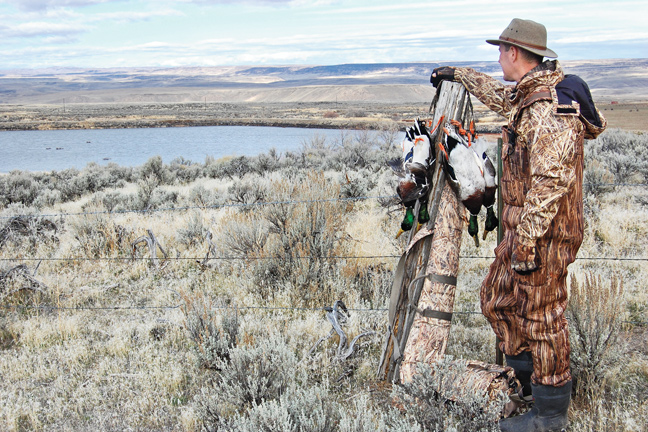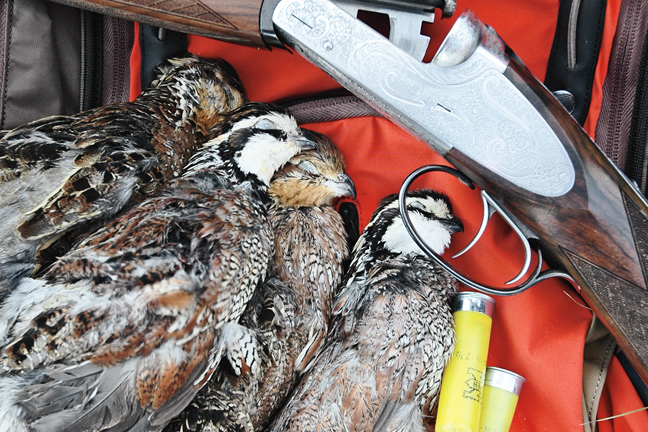Throughout my life I have done a majority of my hunting on public land. Certainly, public lands near major urban centers can get trampled by hunters and their game populations can become depleted.
But farther off the beaten path, public land offers better hunting than private land in many cases, because the habitat on public lands is managed for game and not livestock or maximum yield of row crops.

Here are 10 great public land hunting destinations from west-to-east where you don't have to pay to play. This is by no means a comprehensive list, as I've omitted many good places around the country. But if you feel jilted because I didn't mention your favorite spot, just ask yourself whether you would really want me to make it famous.
1. District 8: Yakima and Kittitas Counties, Wash.
Are you an upland bird hunter who yearns for the freedom of yesteryear? If so, then get in shape and move to Washington. Settle in Washington Division of Fish and Wildlife (DFW) District 8, which offers more multi-species upland bird and waterfowl hunting opportunities on public land than you can tackle in a lifetime of hunting.
Yakima County nearly tops the harvest stats for many bird species, ranking No. 1 in the state for valley quail, No. 2 for doves, No. 3 for both ducks and chukars, No. 4 for pheasants and No. 5 for geese. Hunter densities are low due to sparse human population and the sheer immensity of the public tracts.
Along the breaks of the Columbia River, the Yakima Training Center owns 327,000 acres south of I-90, and the Washington DFW manages another 154,000 acres north of the interstate. West of the Yakima River, hunters can roam the 105,000-acre Wenas Wildlife Area. A motivated upland bird hunter with a good dog could find forest grouse, chukars, Huns,
valley quail and pheasants in the same day.
(509) 575-2740 or wdfw.wa.gov/hunting/prospects/2012/district8.php
2. C.J. Strike WMA: Bruneau, Idaho
When most waterfowl hunters think of "paradise," they are likely to envision the prairies of Canada or the gulf coast of Louisiana and Texas. But one of the best duck hunts of my life took place five years ago on a public wetland in the Snake River drainage of south-central Idaho. Four of us waded over volcanic rock, through tangles of flooded willows in the dark. We set out two-dozen decoys in an opening the size of a Little League infield. Then we shot a limit of greenheads in the first hour after sunrise.
The Idaho Fish and Game (IFG) Department's Southwest and Magic Valley administrative regions encompass several excellent WMAs for upland birds and waterfowl. A good starting point for newcomers is the 10,000-acre C. J. Strike WMA near Bruneau.
In a good year, up to 90,000 ducks and more than 10,000 Canada geese winter on C. J. Strike Reservoir and its adjacent rivers, creeks, ponds and wetlands. A variety of hunting styles can be deployed here, from small-water jump shooting to decoy spreads on big water.
The property also has a wild pheasant population that is augmented by an IFG release program, which stocks the property with pen-raised roosters during hunting season.
(208) 465-8465
3. Game Management Unit 20C: Wickenburg, Ariz.
Let this amazing statistic soak into your brain for a moment: The state of Arizona is approximately 87 percent public land. National Forests and Bureau of Land Management (BLM) holdings constitute much of the state. Four species of quail inhabit Arizona — Valley (California), Gambel's, Scaled and Mearns.
But for a first-timer, I recommend focusing on Gambel's quail, which are the most ubiquitous quail in Arizona. Their range runs south and west of a line from the state's NW corner, through Flagstaff to New Mexico's border.

With so much public land it's hard to pin down one spot, but Game Management Unit 20C is an excellent starting point. Give yourself plenty of time and explore the many BLM holdings throughout this unit. Focus on arroyos and grassland/shrub mix habitat, especially adjacent to stock ponds or creeks, at elevations between 2,000 and 5,500 feet.
Good drainages here include Date Creek, Waterman Creek and Cottonwood Creek. And, in season, keep your eyes peeled for bonus mourning and white-wing doves around those stock ponds.
Contact: Arizona Game & Fish, Region IV: (928) 342-0091; BLM Phoenix field office: (602) 780-8090
4. Cooper and Fort Supply WMAs: Woodward, Okla.
The Hal & Fern Cooper (16,000 acres) and Fort Supply (5,400 acres) WMAs will stretch the legs of a bobwhite hunter and his pointers. Located in northwestern Oklahoma, these areas consist of rolling upland sandhills, river bottoms, mixed grass prairies and sagebrush country with sand plum thickets and salt cedar. Food plots are scattered throughout the river bottom areas, as well.
Management techniques on both areas benefit quail. These techniques include strip disking, controlled burns, prescribed grazing, and other methods that promote native foods like ragweed, croton and sunflower. Duck and goose hunting opportunities are also available on Fort Supply Lake and the marshes along Wolf Creek above the reservoir's inlet. (580) 334-0343
5. The Sandhills: Valentine, Neb.
It's hard to overstate the outdoor recreational potential of the Sandhills ecoregion. Don't let the name fool you; those hills are covered in grass, not sand. (They're made of sand down below, piled up in great dunes by the ancient wind.) At nearly 20,000-square miles, the Sandhills comprise one of the largest remaining grasslands on the continent.
In addition to prairie, the Sandhills contain more than 2,000 small lakes and a million acres of wetlands. Besides great duck hunting, many of those lakes offer excellent bass fishing on days when it just feels too warm to hunt. And did I mention the grouse — sharptails and greater prairie chickens, to be exact?
A good start for newcomers is the 71,000-acre Valentine National Wildlife Refuge. But that is only the beginning. There are more than 800,000 acres of WMAs in Nebraska, and quite a few of them are in the Sandhills.
Refuge: (402) 376-3789 or Nebraska G&P: (402) 471-0641
6. Rusk and Price Counties: Northwestern Wis.
"America's Dairyland" is one of our best ruffed grouse states, and these two counties are full of hotspots for ruffs (and woodcock) on public land. Rusk County forest lands offer more than 90,000 acres of public hunting, and the Flambeau River State Forest represents another 90,000. If that isn't enough to keep you busy, get lost in the nearly endless Chequamegon National Forest.
Still not done? Check out the state of Wisconsin's Managed Forest Law (MFL) program, which opens private forest lands to public hunting by providing tax breaks to landowners. This program has created new access opportunities to more than 64,000 acres in Price County alone.
Rusk County Forestry: (715) 532-2113; Price County Forestry: (715) 339-3027
7. Connecticut Lakes WMA: Pittsburg & Clarksville, N.H.
Nestled along the Canadian border is one of the best and newest public tracts of grouse and woodcock hunting land in all of New England. The 25,000-acre Connecticut Lakes tract is divided into two zones: a 15,000 "Natural Area" that receives no active management, and a 10,000-acre WMA that is actively managed for early successional habitats. If I were going, I'd focus on the managed areas for grouse.
The Connecticut Lakes WMA is remote with few roads, so plan accordingly and bring ample provisions. You should also get in shape, since the area includes five mountain peaks towering as much as 2,000 feet above surrounding lowlands. The area has good grouse numbers, and hunter surveys consistently indicate high satisfaction.
(603) 271-2461
8. "Public Preserve" Pheasants: New Jersey
The state of New Jersey has more than 750,000 acres of public hunting lands, and that number is increasing. As is the case throughout the northeast, wild pheasants are a thing of the past in the Garden State. The state-owned Rockport Pheasant Farm has been propagating pheasants for release onto state WMAs since 1925. Today, the farm produces approximately 50,000 ringnecks for put-and-take hunting throughout the state.
Best places and times to enjoy this bonanza can be found on the New Jersey small game regulations web page listed below. Some of the roomiest "public preserves" include Assunpink WMA (6,300 acres) near Roosevelt and Black River WMA (3,000 acres) near Chester.
9. Game Management Region 3: Eastern Georgia
Oconee National Forest south of Athens, Ga., offers 115,000 acres of public land. Much of the Oconee is marginal bird habitat at best. However, some areas are being managed for early successional habitat with small clear-cuts, in an attempt to save the threatened Red Cockaded Woodpecker. These same areas attract bobwhites, and the Forest Service office can tell you where they are.
Additionally, you'll find woodcock during their fall migration along creek and river bottoms on the Oconee.
For lands managed more specifically for quail (and mourning doves), slip away to the nearby 8,100-acre Di-Lane Plantation WMA. Located near Waynesboro, this area offers bobwhite hunting on a limited quota basis by application. You'll want to check into this well ahead of the season before you plan a trip.
Most of Di-Lane is upland hardwood and pine forest with dense thickets of palmetto, wax myrtle and gallberry, interspersed with grassy meadows and old fields planted to food plots.
Oconee National Forest: (706) 485-1776, www.fs.usda.gov/conf or Di-Lane WMA: (706) 595-4222, www.georgiaoutdoors.com/maps/hunting
10. Southwest Refuge Complex: Bell City, La.
The Cameron Prairie, Sabine, Lacassine and Shell Keys National Wildlife Refuges in southwest Louisiana comprise more than 184,000 acres of public land. This massive coastal wetland complex provides habitat for more than 300 species of birds — and good numbers of alligators, so consider the big lizards before launching your beloved Lab.
These refuges include designated areas for waterfowl hunting. Best refuges for waterfowl hunting are the Sabine and Lacassine, but some areas are by lottery only. The Sabine refuge has more than 34,000 acres open to hunting. This is pintail heaven; the Lacassine refuge alone has a wintering pintail population of almost 400,000.






